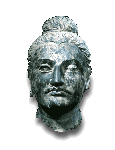Countries and Geography:
| Bactria - (600 BCE - 600 CE) |
An ancient country that occupied present-day Uzbekistan, Tadjikistan and Afghanistan; known as an Asian center of Hellenistic culture. |
| Ferghana |
A fertile valley stretching from present-day Uzbekistan and Kyrgyzstan. |
| Pamirs |
A mountain range in Tajikistan and northeastern Afghanistan. |
| Parthia - (247 BCE - 224 CE) |
An ancient empire centralized in present-day Iran and founded by nomadic peoples from Central Asia. |
| Tarim Basin |
The great sand depression of the Taklamakan Desert located in China's Xinjiang province. The northern and southern routes surrounding this basin were key routes along the Silk Road. |
| Tien Shan |
A mountain range extending through Kyrgyzstan, southeastern Kazakhstan, and western China. |
| Transoxiana |
The region of Central Asia between the Oxus (Amu Darya) and Jaxartes (Syr Darya) rivers. |
Groups:
| Hephthalites - (400 - 565 CE) |
A Central Asian nomadic people who brought the Kushan Empire to an end. |
| Kushans - (1st c. BCE - 1st c. CE) |
The Central Asian nomadic group, originally known as the Yuezhi, that invaded North India. They are credited with adopting Buddhism as their state religion. |
| Sakas - (mid 2nd c BCE - mid 1st c. CE) |
Central Asian nomads who were the descendents of their powerful early nomadic predecessors by the same name. They migrated into present-day Afghanistan. |
| Sogdians - (1st c. - 8th c. CE) |
A long-lived group with Iranian roots who carved out a kingdom in the region of present-day Uzbekistan and Tajikistan. Their main city-states were Bukhara and Samarkand, and they were known as the merchants of the Silk Routes. |
| Xiongnu - (5th c. BCE - 1st c. CE) |
A North Central Asian nomadic group on the boarders of China who controlled the Eurasian steppe |
| Yuezhi - (1st c. BCE - 1st c. CE) |
The North Central Asian nomadic group that migrated to Bactria in the late 2nd c. BCE and eventually invaded north India as the Kushans. |
Individuals:
| Alexander the Great - (356 - 323 BCE) |
The Macedonian ruler who penetrated Central Asia and established an eastern capital, Markanda (Samarkand). His empire marks the domination of Hellenism in the eastern Mediterranean and western Central Asian world. |
| Asoka - (d. 232 BCE) |
The king and son of Chandragupta Maurya who established Buddhism as a state religion in the 3rd c. BCE. |
| Chandragupta Maurya |
Leader of the North Indian dynasty of the 4th c. BCE named after him (Mauryan dynasty) |
| Chang Ch'ien (Zhang Qian) - (d. 114 BCE) |
The first explorer to bring back information on the Yuezhi for the emperor Wu-ti. He explored Central Asia from 139 to 126 BCE. |
| Kanishka |
Ruler of North India during the mid-2nd c. CE whose lineage was nomadic (Yuezhi/Kushan). He was a patron of Buddhism, but followed a Theravada form of Buddhism. He is believed to have encouraged the emergence of the Mahayana doctrine of Buddhism. |
| Wu-ti - (141 - 87 BCE) |
The Han dynasty emperor who sent Chang Ch'ien on his mission to contact the Yuezhi |


